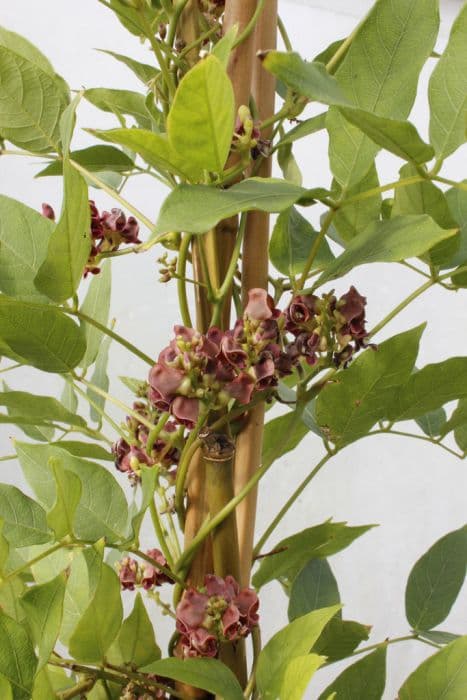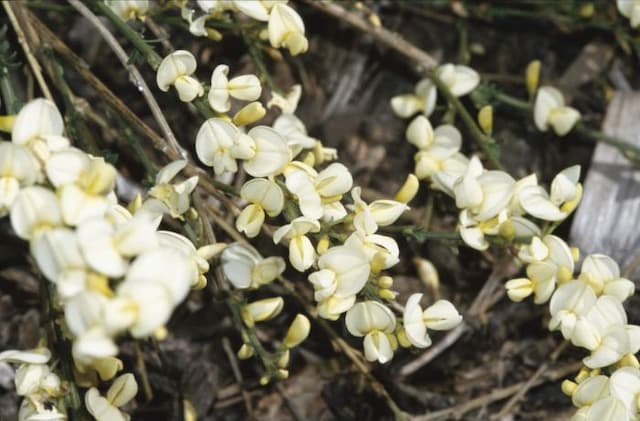Slenderleaf Ticktrefoil Desmodium elegans

ABOUT
Desmodium elegans, commonly known as the elegant tick trefoil, is a flowering plant that typically possesses a branching habit, giving it a bushy appearance. Its stems are slender and may bear small hairs. The leaves are composed of three leaflets, which is a characteristic feature of plants in this genus. The central leaflet is often slightly larger than the side ones, and they usually have a rounded or pointed tip with a broad base. The leaflets exhibit a rich green color and have a smooth, sometimes slightly shiny surface. The flowers of the elegant tick trefoil are aesthetically pleasing, and they usually form in small clusters. Each delicate bloom has a typical pea-like shape, indicative of its family, with petals ranging from pink to purple, adding a touch of color and beauty to the plant. The flowers later give way to small, flat seed pods that exhibit a tendency to stick to clothing and fur, which is a common trait among the tick trefoils, hence their name. Overall, the elegant tick trefoil is noteworthy for its attractive foliage and charming flowers, which contribute to its ornamental appeal and utility in wildflower gardens and natural settings. Its ability to fix nitrogen also makes it beneficial for soil health, which is a valuable trait in agricultural and ecological contexts.
About this plant
 Names
NamesSynonyms
Slender Tick Trefoil, Slenderleaf Tickclover, Showy Ticktrefoil
Common names
Desmodium canum, Meibomia elegans, Hedysarum canum, Desmodium canescens, Meibomia canescens.
 Toxicity
ToxicityTo humans
Desmodium elegans, commonly known as the elegant desmodium or showy tick trefoil, does not have a well-documented profile of toxicity to humans. However, as with many plants, it may cause individual allergic reactions or mild gastrointestinal upset if ingested. There is no specific information detailing severe poisoning consequences from this plant, suggesting that it is not commonly associated with serious toxicity in humans.
To pets
For pets, specifically cats and dogs, there is limited information available regarding the toxicity of Desmodium elegans, or elegant desmodium. It is not commonly listed as a toxic plant to domestic animals. However, animals can sometimes have unpredictable reactions to plants. If a pet ingests some of this plant, watch for signs of gastrointestinal upset such as vomiting or diarrhea, and consult a veterinarian if these symptoms occur or if there is a concern regarding the pet’s health after ingestion.
 Characteristics
CharacteristicsLife cycle
Perennials
Foliage type
Deciduous
Color of leaves
Green
Flower color
Purple
Height
3-5 feet (0.9-1.5 meters)
Spread
2-3 feet (0.6-0.9 meters)
Plant type
Shrub
Hardiness zones
4
Native area
Asia
Benefits
 General Benefits
General Benefits- Nitrogen Fixation: Desmodium elegans, being a legume, has the ability to fix nitrogen in the soil through its symbiotic relationship with bacteria, which can improve soil fertility for other plants.
- Erosion Control: Its deep root system helps stabilize soil and prevent erosion, particularly useful on slopes and in areas prone to land degradation.
- Forage for Livestock: Provides nutritious forage for animals such as cattle, goats, and sheep, improving livestock productivity.
- Habitat for Wildlife: Offers habitat and food sources for a variety of insects and birds, thus fostering biodiversity.
- Ornamental Value: Appreciated for its elegant appearance, it can be used as an ornamental plant in gardens and parks.
- Improving Crop Systems: Can be used in intercropping systems to benefit neighboring crops with its nitrogen-fixing capabilities.
 Medical Properties
Medical Properties- Anti-inflammatory: Desmodium elegans may have compounds that help reduce inflammation in the body.
- Antioxidant: The plant contains antioxidants that might protect cells from damage caused by free radicals.
- Antimicrobial: It has been studied for potential antimicrobial properties that could inhibit the growth of certain bacteria and fungi.
- Hepatoprotective: There is some evidence to suggest that Desmodium elegans could help protect the liver from certain types of damage.
- Antidiabetic: Some research indicates that extracts of the plant might be beneficial in managing blood sugar levels.
- Diuretic: The plant may promote the production of urine, which can help in the treatment of conditions like hypertension and edema, although these uses are not clinically proven.
 Air-purifying Qualities
Air-purifying QualitiesThis plant is not specifically known for air purifying qualities.
 Other Uses
Other Uses- Desmodium elegans, commonly known as Elegant Bush-pea, has been traditionally used in some cultures as a natural dye for fabric, providing a range of hues depending on the mordant used.
- The leaves of the Elegant Bush-pea have been utilized as livestock fodder, particularly for goats, in regions where it grows abundantly.
- In agroforestry systems, the Elegant Bush-pea can be incorporated as a cover crop to improve soil quality and reduce erosion due to its dense root system.
- Gardeners sometimes cultivate Desmodium elegans for its ornamental value, as it can add color and texture with its purple flowers to mixed borders or wildflower gardens.
- The stems and fibers of this plant have been used in the crafting of small household items such as mats and baskets in various indigenous communities.
- Elegant Bush-pea is sometimes used as a companion plant in gardens to attract beneficial insects that prey on pests, thanks to its nectar-rich flowers.
- In some cultures, the plant has been used in rituals or as a part of ceremonial garlands due to its appealing flowers and foliage.
- The plant has been used in ecological restoration projects to help stabilize soil and rehabilitate degraded lands with its resilient growth habits.
- Due to its dense growth, Elegant Bush-pea can be used as a privacy screen in gardens or as a natural boundary marker in rural areas.
- Children in some regions fashion toys or playthings from the flexible branches and pods of Desmodium elegans.
Interesting Facts
 Feng Shui
Feng ShuiThe Desmodium elegans, commonly known as the Tick Trefoil, is not used in Feng Shui practice.
 Zodiac Sign Compitability
Zodiac Sign CompitabilityThe Tick Trefoil is not used in astrology practice.
 Plant Symbolism
Plant Symbolism- Connection: Desmodium elegans, commonly known as Elegant Bush Clover, features a network of interconnected roots which symbolizes interdependence and the importance of relationships.
- Adaptability: This plant's ability to thrive in various conditions suggests the symbolism of adaptability and resilience in the face of environmental challenges.
- Elegance: The term "elegant" in its common name hints towards grace and beauty, suggesting the symbolism of poise and delicate aesthetics.
- Growth: As a plant that grows and spreads with ease, it symbolizes personal growth and the idea of continuously reaching out for new experiences or knowledge.
- Harmony: The balanced and orderly growth pattern of the Elegant Bush Clover signifies harmony and the peaceful coexistence with surrounding nature.
 Water
WaterFor the Desmodium elegans, commonly known as Slender Tick Trefoil, it is essential to maintain moist soil, especially during the growing season. You should water generously, allowing the top inch of soil to dry out before watering again, which might mean watering once every week. The actual frequency, however, can vary depending on the environment, like humidity and temperature, so it's important to monitor the soil moisture. When you water, do so thoroughly until water runs freely from the bottom of the pot, ensuring the root system is being reached. Depending on the pot size and the plant's needs, this could amount to between 16 to 32 ounces of water during each watering session.
 Light
LightSlender Tick Trefoil thrives best in bright, indirect light. It should be placed in a location where the lighting is bright but filtered, such as near a window with a sheer curtain or in a bright room without direct sun exposure. Direct sunlight can scorch the leaves, while too little light can cause leggy growth and poor flowering.
 Temperature
TemperatureSlender Tick Trefoil prefers temperatures between 60 to 75 degrees Fahrenheit for optimal growth. It can withstand a minimum temperature of 50 degrees Fahrenheit and a maximum of 80 degrees Fahrenheit. The plant should be kept away from cold drafts and sudden temperature changes to prevent stress.
 Pruning
PruningPruning Slender Tick Trefoil promotes denser growth and can help maintain a desirable shape. Prune in the early spring before new growth begins. Removing dead or damaged stems and thinning out overly crowded areas will improve air circulation, which is key to preventing diseases. Frequently trimming leggy stems can also encourage a bushier plant.
 Cleaning
CleaningAs needed
 Soil
SoilFor Desmodium elegans, commonly known as the Elegant Tick Trefoil, the ideal soil mix is well-draining, rich in organic matter, and lightly acidic to neutral in pH, ranging from 6.0 to 7.0. A combination of loamy soil with added compost or peat can work well to support its growth.
 Repotting
RepottingElegant Tick Trefoil should be repotted every couple of years or when it outgrows its current container. It's best to repot in the spring at the start of its active growth period.
 Humidity & Misting
Humidity & MistingElegant Tick Trefoil prefers moderate to high humidity levels. Aim to maintain humidity around 50 to 60 percent for optimal growth.
 Suitable locations
Suitable locationsIndoor
Place Elegant Tick Trefoil by a bright window; water when topsoil is dry.
Outdoor
Plant Elegant Tick Trefoil in partial shade; water regularly.
Hardiness zone
4-8 USDA
 Life cycle
Life cycleDesmodium elegans, commonly known as elegant tick trefoil, begins its life cycle as a seed which germinates in favorable conditions of warmth and moisture, typically in spring. The seed develops into a seedling with the growth of its first true leaves, and as it matures, the plant forms a deep taproot and begins vegetative growth. During its growth, elegant tick trefoil exhibits a bushy form with trifoliate leaves and stems that may either sprawl or grow upright. It enters the reproductive stage and flowers in the summer; the flowers are usually purple or pink, and after pollination, these flowers develop into small, hairy seed pods that cling to animals and clothing for dispersal. After seed dispersal in late summer or autumn, the plant may die back if it is an annual, or if perennial, it may enter a period of dormancy during the colder months. In its perennial form, elegant tick trefoil will resprout from its root system when conditions become favorable in the following spring.
 Propogation
PropogationPropogation time
Spring-summer
Desmodium elegans, commonly known as showy tick trefoil, is often propagated by seeds, which is considered the most popular method. The best time to sow the seeds of showy tick trefoil is in late winter or early spring when the threat of frost has passed. Before sowing, it is often recommended to scarify the seeds gently to break their hard coat, which can be done by lightly rubbing them with sandpaper or nicking them with a knife, and then soaking them in water for 12 to 24 hours to improve germination rates. Once prepared, the seeds should be sown at a shallow depth of about 1/4 inch (about 6 millimeters), either directly in the intended growing area or in seed-starting trays if transplanting is desired. Germination typically occurs within 2 to 3 weeks under warm conditions, and seedlings can be transplanted to their permanent location once the risk of frost has passed and they are large enough to handle.









